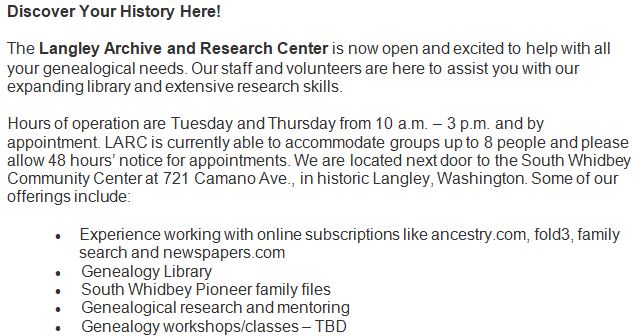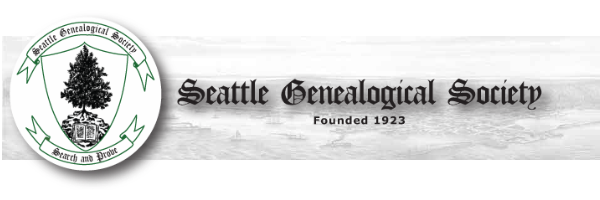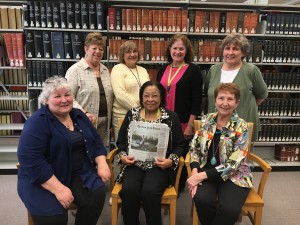




TIP OF THE WEEK –
HELP WITH YOUR OLD PHOTOS
On our Seattle Genealogical Society Networking Group Facebook page, a
member posted this question, “I’m wondering if there’s a safe process
for bringing out what’s written on the back of old photograph cardboard
stock that the photo was mounted on. Looks like maybe pencil”.
Several members replied they have had luck scanning the back of the
photograph at the highest resolution possible and then using a photo
editing application to adjust the contrast and brightness, etc.
Possibly with this technique, you will be able to make out what was
written on the back of that precious old photograph.

TIP OF THE WEEK
AMERICAN ANCESTOR ACCESS
Established in 1845, the New
England Historic Genealogical Society (NEHGS) is America’s founding
genealogical organization, one of the most respected names in family
history, and the largest society of its kind in the world.
AmericanAncestors.org by the New England Historic Genealogical Society
is one of the most widely used online genealogical resources in the
world, providing access to over 1.4 billion searchable records. Records
that reach beyond New England; they cover the entire United States, the
British Isles, continental Europe, and more. AmericanAncestors.org also
provides many educational resources.
A
perk of visiting the SGS Library, you can access AmericanAncestors.org
absolutely free of charge to you from one of our patron computers. Come
see what you can discover about your ancestors in this top-notch
database.

TIP OF THE WEEK
NEW GOOGLE MAPS TOOL
Randy Majors, creator of the much loved “Historical U.S. County
Boundaries Map”, as well as the tools “County Lines on Google Maps” and
“City Limits on Google Maps”, has done it again. He just released a
new tool, “Township Range on Google Maps”.
If you need to map Township/Range/Section, you can map them all the
way down to the quarter quarter section. These townships are part of
the Public Land Survey System (PLSS) found in roughly 30 states in the
USA. Search by address, place, GPS coordinates, or do a reverse find by
Section, Township, Range.
His website https://randymajors.com
is a good place to read about and sample all his tools, as well as the
place to stay abreast of what he plans to develop and release next.
Have you found a DNA match but you can’t figure out how you are related? Who is your Most Recent Common Ancestor (MRCA)? DNA Painter is a fairly new tool that just might solve the puzzle.
DNAPainter.com is a free on-line program that “paints” (pastes, really) your DNA comparison with a match. It uses a chromosome browser from 23andme, MyHeritage or FamilyTreeDNA. It will not work with Ancestry.com DNA as that site does not have a chromosome browser. And you will need permission from your match to share chromosome information.
First of all, read the tutorial which will walk you through the step-by-step process. It takes about an hour to do the tutorial. You don’t need to completely understand the science of what all those numbers mean. Just remember: the greater the number of centiMorgns (cMs) you share with a match, the more closely you are related.
You then begin painting matches into Painter. I recommend starting with a known cousin to use as a control. I chose a known maternal cousin and a known paternal cousin.
When you paste a match into DNA Painter, the shared segments show up as a colored line on various chromosomes. As you paint more and more matches you will see where the segments overlap. It is a very graphic visual that shows those overlapping segments in a very visual pattern.
Using known cousins gives you clues as to which side the unknown matches are on. Once you know which side of the family your match is on, you can then start searching for documentation. Of course, you will be emailing back and forth with your match to exchange more information.
If you don’t have any known cousins, don’t worry, Painter still can help you. Once you have painted several matches you will begin to see patterns. Since several of the DNA testing sites also ask you for your ancestors’ birth places, you can compare that information with your matches. Also, your ethnicity and your matches ethnicity estimates provide clues.
DNA Painter is not the be all and end all of genealogical research. It is a very helpful tool. Give it a try. You just may get hooked!
This is from Barbara Gorham Johnson the WSGS Region 1S representative. Thanks Barbara. You too can have your blog post published here, just contact me charlesmike4903@gmail.com
American Ancestors has started the GU272 Memory project which is a project that several EWGS Members form Spokane have worked on. Patricia Bayonne-Johnson a former EWGS president had found out with the help of a paid genealogist that her Butler family had been born in Maryland, were Catholic and ended up in Louisana. She formed the Butler group in Spokane and wrote a blog post on the information they had found.

This is 7 of the 8 members of the Butler Group Pat formed at the Spokane Public Library. Georgetown was pretty sure none of the 272 slaves they had sold had lived until they found the blog post Pat had done on finding her family from Maryland.
Today the GU272 Georgetown project has found more than 8000 descendants of the original slaves sold to start Georgetown University and they are still searching for more. Check here to see how to search to see if you have an ancestor connected with the GU272 Memory Project or to help with the project.

TIP OF THE WEEK WEEK – IRISH NAMING PATTERN
Looking back through the centuries in Ireland, there has traditionally been a very strong naming pattern for the children born into a family. Perhaps knowing this pattern will assist you in your research.
eldest son usually named after his paternal grandfather
second son usually named after his maternal grandfather
third son usually named for his father
fourth son usually named for his father’s eldest brother
fifth son usually named for his mother’s eldest brother
eldest daughter usually named after her maternal grandmother
second daughter usually named after her paternal grandmother
third daughter usually named for her mother
fourth daughter usually named for her mother’s eldest sister
fifth daughter usually named for her father’s eldest sister
A while back I wrote an article telling of the WSGS Facebook page, but here is a list of genealogy Facebook Groups so If you do not do Facebook, there may be a Facebook group that interests you.

TIP OF THE WEEK WEEK – UNTAPPED RECORD FILES
RELATED TO THE HOMESTEAD ACT OF 1862 Many genealogists are familiar with the Bureau of Land Management (BLM) website and use that site to see if their ancestors acquired land under the Homestead Act, or by any of the other federal land acts. On this website, one can see the legal description of the land, along with a digital image of the patent itself.
But many people do NOT know that there is a file associated with each patent, that is not online. Both the affidavit of eligibility and the proof required for the patent after five years may contain detailed genealogical information. In many cases, because non-citizens were eligible to claim land but only citizens could receive a patent, the actual naturalization records of the claimants may be found in the files. Other files, by widows or children of the original claimant, may include marriage or birth records.
The Homestead file itself is available through the National Archives, for a fee of $50.
For more information about these records, and how to order them, see The Legal Genealogist article titled “Happy Birthday, Homestead Act” by Judy Russell at https://www.legalgenealogist.com/blog/ . Just scroll down to the May 20, 2019 post.
One can sign up to subscribe to The Legal Genealogist at no charge and receive it as a daily email. Her daily blog posts are frequently very interesting and informative, as this one is. Consider this a bonus Tip of the Week!

TIP OF THE WEEK – THE LIBRARY OF VIRGINIA’S ONLINE CATALOG
The Library of Virginia in Richmond holds and preserves all the
records of the state of Virginia. Its library catalog is readily
searchable online, and just as with familysearch.org, an increasing
number of their records have been digitized and are accessible online.
For instance, searching under the Images and Indexes tab (see below) gives you a list of over thirty digitized, searchable collections, including Revolutionary War Bounty Warrants and Land Office Military Certificates; Henley’s Marriage/Obituary Index of Virginia Newspapers; and Virginia Land Office Patents and Claims, to name just a few.
To view this section of their catalog, go to their main web page: ( http://www.lva.virginia.gov/ ) and scroll down slightly till you see For The Public; click there (everything under that tab is worth exploring!) select Search the LVA Catalog. This opens a new page, with 4 tabs; click on Images and Indexes. Then select which collection(s) you’d like to search.